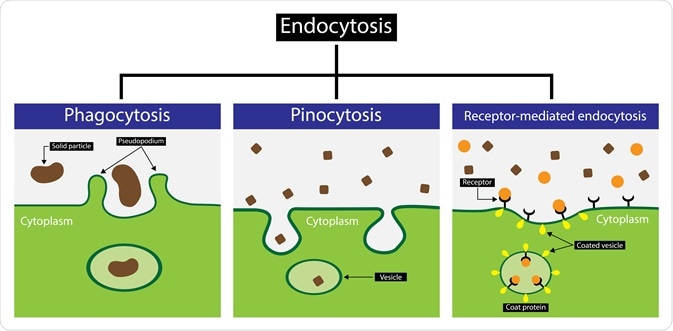Endosomes are membrane-bound cytosolic vesicles with three major compartments namely early, late, and recycling endosomal compartments. Endosomes are the integral parts of the endocytic process, and thereby, play crucial roles in various physiological processes, such as nutrient uptake, sorting and delivery of macromolecules, and regulation of cell surface receptors and transporter expressions.
 Image Credit: Nasky/Shutterstock.com
Image Credit: Nasky/Shutterstock.com
What are endosomes?
Eukaryotic cells engulf macromolecules and other substances from the surrounding medium by endocytosis. A portion of the plasma membrane invaginates to engulf the substances to be internalized, which subsequently buds off into the cell and forms a vesicle containing the internalized substances.
These vesicles are then fused with early endosomes, which are the main sorting compartment of the endocytic pathway. From early endosomes, internalized substances are either recycled back to the plasma membrane or transported to lysosomes for degradation.
Early endosomes contain two types of domains: tubular and vacuolar. Late endosomes are generated from the vacuolar domains and located near the nucleus. Substances targeted for lysosomal degradation are transferred from early endosomes to late endosomes by endocytic carrier vesicles.
Transport vesicles that carry lysosomal hydrolases from the trans-Golgi network (TGN) then fuse with late endosomes, leading to maturation of late endosomes into lysosomes. Inside lysosomes, acid hydrolases catalyze the degradation of internalized substances.
A portion of the internalized substances does not enter late endosomes and rapidly recycled back to the plasma membrane. Such substances are transferred from the sorting endosomal compartment to the endocytic recycling compartment via narrow-diameter tubules. Substances are recycled back to the plasma membrane by transport vesicles that bud off from the endosomal tubular domains.
What are the functions of endosomes?
Endosomes play active roles in many important physiological processes. One of the major functions of endosomes is the regulation of the transmembrane receptor/transporter expression.
Transmembrane receptor signaling
The binding of the ligand to the extracellular domain of the transmembrane receptor initiates a cascade of signaling events that are vital for maintaining communication between the intracellular and extracellular environments. Upon activation by ligands, these transmembrane receptors enter the endosomal pathway, which determines the fate of the receptor-mediated signaling events.
The receptor-ligand complex that is targeted for internalization is assembled in a specific plasma membrane region called clathrin-coated pits. These regions invaginate to engulf the receptor-ligand complex and subsequently bud off from the plasma membrane to form clathrin-coated vesicles. This process is called endocytosis.
These vesicles subsequently fuse with early endosomes where the sorting of the internalized receptor-ligand complex is carried out. Endosomal network-mediated targeting of the internalized complex for lysosomal/proteasomal degradation leads to termination of the receptor-mediated signaling events; whereas, recycling of the receptor back to the plasma membrane leads to the continuation of the signaling events.
Nutrient uptake
Another example of the receptor-mediated endosomal activity is the cellular uptake of cholesterol via the low-density lipoprotein (LDL) receptor. In the blood, cholesterol is mostly transported as LDL, and uptake of LDL by eukaryotic cells depends on the binding of LDL to its receptor located in the clathrin-coated pits.
Upon internalization and fusion to early endosomes, the LDL receptor detaches from its ligand, LDL, and recycled back to the plasma membrane, whereas LDL is transported to lysosomes, leading to degradation of LDL and release of cholesterol for cellular use. The acidic environment inside early endosomes facilities the receptor-ligand dissociation process.
Nerve impulse transmission
Endosomes are vital for regulating nerve impulse transmission between synapses. Upon generation of the action potential, presynaptic vesicles are fused with the plasma membrane, leading to the release of neurotransmitters and propagation of signals to the postsynaptic neurons.
These presynaptic vesicles are then removed from the plasma membrane via endocytosis and taken up by the early endosomes, where regeneration of the synaptic vesicle takes place. These newly formed synaptic vesicles containing neurotransmitters are then recycled back to the plasma membrane.
Clathrin-independent endocytosis
Besides endosomal uptake via clathrin-coated pits, some membrane proteins and extracellular fluids are internalized via specialized vesicles called caveolae. These vesicles are composed of a protein called caveolin and are enriched in the lipid raft of the plasma membrane.
Endocytosis, phagocytosis, and pinocytosis | Biology | Khan Academy
Endosomes in human diseases
Endosomal dysfunction is associated with many health conditions. For example, patients with hypercholesterolemia display high blood cholesterol levels which can lead to an eventual heart attack. High blood cholesterol is due to the inability to uptake LDL by the cells. Two mutations in the LDL receptor is responsible for the impaired endocytic process.
Of two mutations, one prevents the binding of LDL with its receptor, and the other one prevents the accumulation of LDL receptors in the clathrin-coated pits. As a consequence, the LDL – LDL receptor complex cannot be internalized and processed by the endosomal pathway.
In patients with Alzheimer’s disease, endosomal dysfunction is associated with early neurodegenerative characteristics, including proteolytic cleavage of amyloid precursor protein and generation of toxic beta-amyloid peptide.
References
Further Reading
Last Updated: Mar 16, 2021